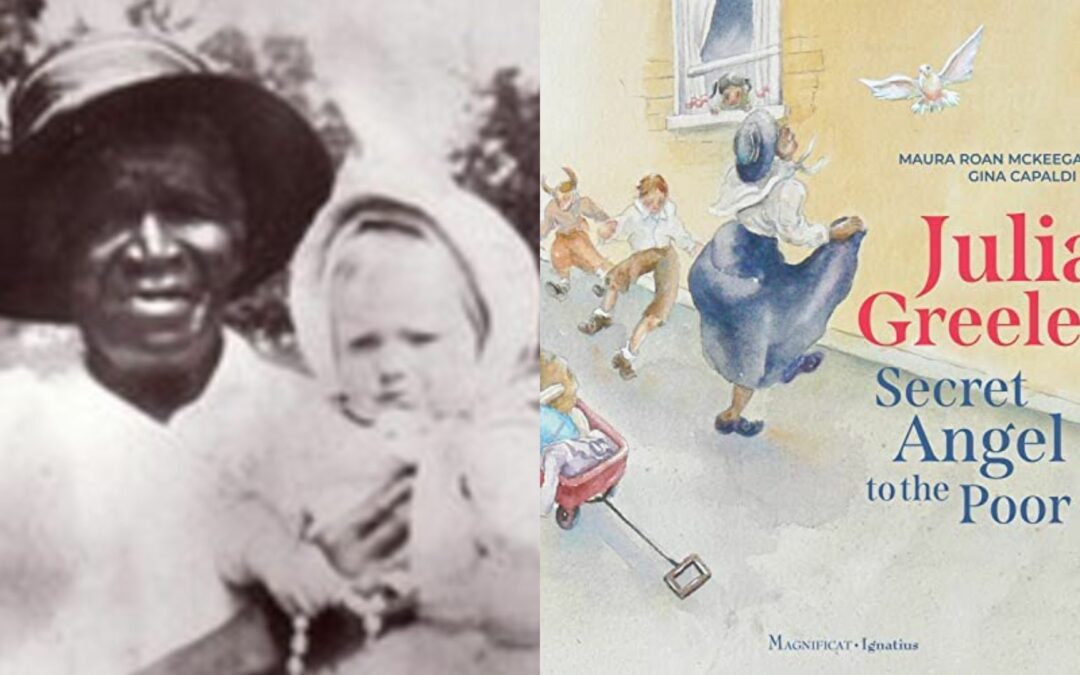Secret Angel to the Poor (Catholic Black History)
Catholic Black History Month Series: Julia Greeley, Secret Angel to the Poor by Maura Roan McKeegan and illustrated by Gina Capaldi
This month we are reviewing Catholic books that focus on the lives and contributions of African Americans. Today I am going to take a look at a great new picture book about an outstanding example of everyday holiness from Colorado’s frontier days.
Angel of Charity
If you lived in the city of Denver at the turn of the last century, Old Julia would have been a familiar sight. There was no mistaking Julia: an old African American woman with a deformed eye, hunched over from arthritis, shuffling down Denver’s streets pulling a red wagon full of odds and ends.
If you’d seen Old Julia, you might assume she was some kind of beggar. But looks can be deceiving, as this was no beggar, but Servant of God Julia Greeley, Denver’s “Angel of Charity.” Her story is told in a new book from Magnificat and Ignatius Press titled Julia Greeley, Secret Angel to the Poor by Maura Roan McKeegan and Gina Capaldi.
A little historical background: Julia Greeley was born into slavery in Missouri. When she was young, her eye was permanently deformed from the lash of a slave master’s whip, earning her the nickname “One-Eyed Julia.” After the Civil War, Julia moved to Denver to serve as cook and nanny to Julia Dickerson, a widow who would go on to marry Colorado’s first territorial governor, William Gilpin.
Conversion
In Denver, Julia was introduced to Catholicism and embraced the Catholic faith, receiving baptism on June 26, 1880 in Sacred Heart Church in Denver. Julia had a special devotion to the Sacred Heart and was a daily Mass-goer. After the death of her employers, she decided to devote her remaining days to charity. Wishing to emulate the poverty of St. Francis, she joined the Third Order Franciscans and remained an active member until her death. She took the Gospel message to heart and, despite crippling arthritis, walked the streets of Denver collecting coal, blankets, food, or anything else with value. These items were given to the poor—generally after dark and anonymously, as Julia believed some people would be too embarrassed to take charity from a poor black woman.
Julia Greeley, Secret Angel to the Poor, introduces us to the work of Julia Greeley. It is not a biography per se, but a “day in the life” style work, following Julia around Denver on a fictionalized average day. We see Old Julia collecting coal, distributing food, helping young mothers, soliciting donations, handing out Sacred Heart holy cards, repairing old toys to regift, and stopping in her spiritual home, Sacred Heart parish, multiple times for prayer. The book’s portrayal of an “average day” for Julia Greeley demonstrates a life filled to the brim with the corporal works of mercy. Julia Greeley performed more charitable works in a single day than many of us do in a year.
Devotion
One excellent lesson the book draws out is how God uses us to answer the prayers of others. Julia was not called Denver’s “Angel of Charity” for nothing; she was always attentive to the needs of others, and when she became aware of someone suffering, she took active steps to relieve them—to be the angel of charity for that person. When God answers prayers, He often does it through the kindness of others.
Julia Greeley’s devotion to charity in the name of Jesus transcended racial division in a time that is often described as the nadir of race relations in the United States. She was beloved by her entire community, white and black. When she died in 1918, her body was laid in repose in the chapel of St. Ignatius Loyola parish, the only lay person to ever be so honored in Denver (this chapel is typically reserved for the reposition of deceased clergy) She was mourned by thousands. It is no surprise a cause has been opened for her canonization.
Conclusion
The book is about 40 pages of text with charming watercolor illustrations. The book is recommended for ages 7 and up; I read it with my kids, and I think age 8-10 is the sweet spot. You could combine this book with others in this review series to build a history unit study.
In full disclosure, I was given a review copy of this book by the publisher, but I would recommend it even if I had not been. I did not know about Julia Greeley and the book did a fantastic job of showing exactly why this remarkable old woman who pulled a red wagon around Denver is still being honored and venerated over a century after her death.
For more: Join Arlena Brown on the Homeschooling Saints Podcast to learn about the contributions of black Catholics and how to integrate the lessons of their holy lives into our homeschools,






